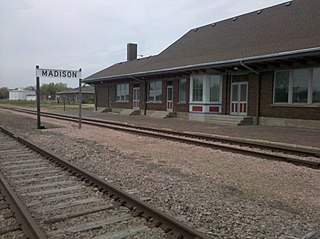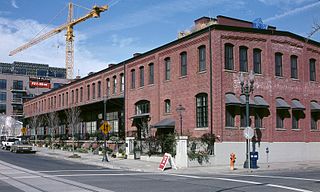
Harlowton is a city in and the county seat of Wheatland County, Montana, United States. The population was 955 at the 2020 census.

The Chicago, Milwaukee, St. Paul and Pacific Railroad (CMStP&P), better known as the Milwaukee Road, was a Class I railroad that operated in the Midwest and Northwest of the United States from 1847 until 1986.

The Olympian and its successor the Olympian Hiawatha were passenger trains operated by the Chicago, Milwaukee, St. Paul and Pacific Railroad between Chicago and the Pacific Northwest. The Olympian operated from 1911 to 1947 and was, along with its running mate the Columbian, the first all-steel train to operate in the Pacific Northwest. The streamlined Olympian Hiawatha operated from 1947 to 1961 and was one of several Milwaukee Road trains to carry the name "Hiawatha." The Olympian Hiawatha was designed by industrial designer Brooks Stevens and included the distinctive glassed-in "Skytop" observation-sleeping cars. It later featured full-length "Super Dome" cars.

Avery is a small unincorporated community in the northwest United States, located in the St. Joe River Valley in Shoshone County, Idaho. Avery is located in the middle of the St. Joe District of the Idaho Panhandle National Forest, and is a tourist attraction in the Idaho Panhandle known for its wilderness and outdoor recreation. It is upstream and east of St. Maries, the county seat of Benewah County.

The Chicago, Milwaukee, St. Paul and Pacific Depot Freight House and Train Shed, now officially named The Depot, is a historic railroad depot in downtown Minneapolis, Minnesota, United States. At its peak, the station served 29 trains per day. Following decline, the station was closed and eventually adapted into various other uses.

The Palouse to Cascades State Park Trail, formerly known as the John Wayne Pioneer Trail and the Iron Horse Trail, is a rail trail that spans most of the U.S. state of Washington. It follows the former railway roadbed of the Chicago, Milwaukee, St. Paul & Pacific Railroad for 300 miles (480 km) across two-thirds of the state, from the western slopes of the Cascade Mountains to the Idaho border.

Winona station, formerly known as the Chicago. Milwaukee & St. Paul Railway Station, is a historic train station in Winona, Minnesota, United States. It is served by Amtrak's daily Empire Builder service. It was originally built in 1888 by the Chicago, Milwaukee, St. Paul and Pacific Railroad, known later as the Milwaukee Road. A former Milwaukee Road freight house also exists here.

Elberon is a railway station in the Elberon section of Long Branch, Monmouth County, New Jersey, United States. The station is served by New Jersey Transit's North Jersey Coast Line. Located at the intersection of Lincoln Avenue and Truax Road, It is the first station south of the electrified section of the line. The station has two side level high-level platforms and 229 parking spaces for commuter use.

Attleboro station is a commuter rail station on the MBTA's Providence/Stoughton Line located in Attleboro, Massachusetts. By a 2018 count, Attleboro had 1,547 daily riders, making it the fourth busiest station on the system outside Boston.

The Milwaukee Road Bunkhouse was built by the Chicago, Milwaukee, St. Paul and Pacific Railroad in 1909 to house train crews between shifts. The bunkhouse served the crews at the rail yard and division point at South Cle Elum, Washington. The bunkhouse is an L-shaped, two-storey, wood-frame vernacular building originally placed near the depot, but moved to its present location south of the rail yard around 1920 to accommodate the electric substation when the Milwaukee Road electrified. The bunkhouse continued to serve train crews until 1974. When the railroad ceased operations in Washington in 1980, it sold the property to private individuals who converted the bunkhouse into a bed and breakfast.

The Chicago, Milwaukee, St. Paul and Pacific Railroad South Cle Elum Rail Yard located in South Cle Elum, Washington, was a division point on the Chicago, Milwaukee, St. Paul and Pacific Railroad's Coast Division. It was established by the railroad in 1909 during construction of its "Pacific Extension".

The Chicago, Milwaukee, St. Paul & Pacific Railroad-Kittitas Depot is a railroad station in Kittitas, Washington, United States, that was built in 1909 by the Chicago, Milwaukee and St. Paul as part of the railroad's Pacific Extension.

The Geraldine Milwaukee Depot was built by the Chicago, Milwaukee, St. Paul and Pacific Railroad in 1914. The depot is a rectangular one-story wood-frame building built in the Craftsman style.

The Milwaukee Railroad Depot in Alberton, Montana was built by the Chicago, Milwaukee, St. Paul and Pacific Railroad in 1908, during its Pacific Extension from Chicago, Illinois to Tacoma, Washington from 1906 to 1909. The depot is a rectangular one-story wood-frame building constructed in the Craftsman style.

The Chicago, Milwaukee, St. Paul and Pacific Railroad Depot and Lunchroom are two buildings located in Wells, Minnesota, and built by the Chicago, Milwaukee, St. Paul and Pacific Railroad in 1903.

The Chicago, Milwaukee, St. Paul and Pacific Railroad Depot was built by the Chicago, Milwaukee, St. Paul and Pacific Railroad in 1906. It is located at the south end of the business district in Madison, South Dakota. The building is a rectangular single-story brick structure. It housed men's and women's waiting rooms, a lunch room ("beanery"), station agent's office, and a freight room. Rather than being a wood-frame building, as was usual for smaller, rural stations, the depot at Madison was built of brick.

The North Bank Depot Buildings, in central Portland, Oregon, United States, are a pair of buildings formerly used as a freight warehouse and passenger terminal for the Spokane, Portland and Seattle Railway (SP&S). Formed in 1905, the SP&S was commonly known as the North Bank Road during the period in which these buildings were in use. The Portland buildings' passenger facilities were also used by the Oregon Electric Railway after that railway was acquired by the SP&S. Located in what is now known as the Pearl District, the buildings were listed on the National Register of Historic Places in 1996. They were in use by the SP&S and its successor, Burlington Northern Railroad, from 1908 until the 1980s. Only the east building was used as a passenger station, and this usage lasted from 1908 until 1931.

The Johnson Railroad Depot was a historic former railroad station on Railroad Street in Johnson, Vermont. Built in 1887, it was an excellent example of Victorian railroad architecture, serving as a gateway for the town's industrial products to markets nationwide. Converted to commercial use after rail service was discontinued on the line, it was listed on the National Register of Historic Places in 1980. It has since been demolished; a modern building stands where it used to.

The Milwaukee Road Depot in Madison, Wisconsin is a railroad depot built in 1903 and operated by the Chicago, Milwaukee, St. Paul and Pacific Railroad. It served numerous passenger trains, including the Sioux and Varsity, and was located next to a major yard, turntable, and roundhouse. The station was one of two Milwaukee Road stations in Madison, and was also known as West Madison station or West Madison Depot to avoid confusion with Franklin Street station on the east side of Madison. All Milwaukee Road passenger service in Madison was consolidated to this station with the closing of Franklin Street in 1952. The Milwaukee Road's service from Chicago to Minneapolis-St. Paul traveled through Milwaukee and central Wisconsin, bypassing Madison to the north. The railroad's competitor, the Chicago and North Western Railroad, offered direct service northwest to Minneapolis.

Marion station was a railroad station in Marion, Iowa. It served passenger trains of the Chicago, Milwaukee, St. Paul and Pacific Railroad, commonly known as the Milwaukee Road. After passenger train service was discontinued, elements of the station were moved across the street to City Square Park, where it remains as a pavilion today. The structure is listed as a non-contributing property by the National Register of Historic Places in the Marion Commercial Historic District.
























